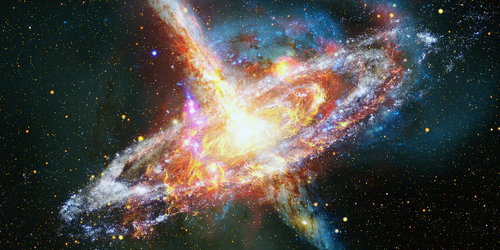Milky Way Pulsars Rule Out Some Extremely Light Dark Matter Particles
In the hunt for dark matter, physicists are working to turn over every stone until they find—or rule out—all of the places it may be hiding. The European Pulsar Timing Array (EPTA) collaboration now eliminates a previously unexplored corner of dark matter phase space by monitoring the Milky Way’s pulsars [1].
Pulsars are rapidly spinning neutron stars that emit up to several hundred electromagnetic flashes per second. The regularity of these flashes rivals the precision of the best atomic clocks, making pulsars ideal cosmic timekeepers. Spacetime distortions caused by gravitational waves passing between pulsars and Earth impact the regularity of these ticks, however, allowing a network of pulsars to act as a galaxy-sized gravitational-wave detector. Scientists recently demonstrated this technique, capturing the background gravitational-wave signal of the Universe using an array of 67 of the Milky Way’s pulsars (see Research News: Researchers Capture Gravitational-Wave Background with Pulsar “Antennae”).
The EPTA collaboration explored the possibility that pulsars can also act as dark matter detectors. Specifically, the researchers searched for ultralight dark matter—the lightest dark matter candidate—which is predicted to be distributed nonuniformly throughout our Galaxy. Accumulations of the particles create local gravitational potential wells that oscillate in depth with a period that depends on the particles’ masses. For large enough dark matter clumps, this oscillation would induce small, but measurable, variations in the arrival times of electromagnetic pulses, imprinting a secondary periodic pattern on top of the pulsar’s signal.
Finding no such pattern in data for 25 pulsars, the EPTA collaboration placed an upper limit on the possible density of ultralight dark matter with particle masses of 10−24.0 to 10−23.3 eV. While the results leave open the possibility that higher-mass ultralight dark matter particles exist in the Milky Way, such particles could—at most—make up 60%–70% of our Galaxy’s dark matter, according to the collaboration’s analysis.
–Katherine Wright
Katherine Wright is the Deputy Editor of Physics Magazine.
References
- C. Smarra et al. (European Pulsar Timing Array), “Second data release from the European Pulsar Timing Array: Challenging the ultralight dark matter paradigm,” Phys. Rev. Lett. 131, 171001 (2023).




